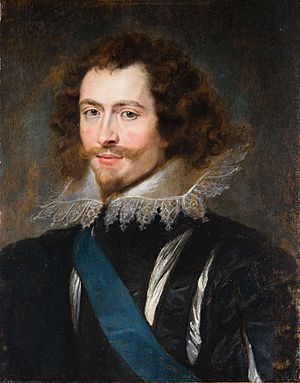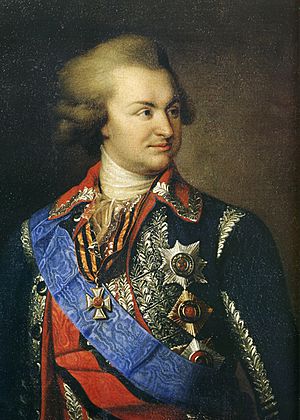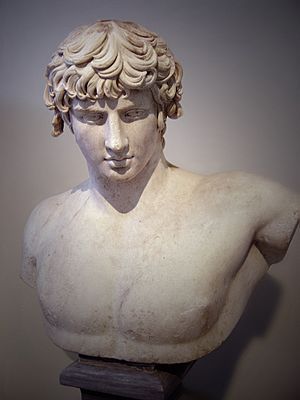Favourite facts for kids
A favourite was a close companion or trusted advisor to a ruler, like a king or queen. These individuals were given a lot of political power by the ruler. This idea of a "favourite" was especially common in Europe during the 16th and 17th centuries.
At that time, running a government became very complicated. Many rulers inherited their positions but weren't always interested in or good at governing. So, they often relied on a favourite to help them. Between 1600 and 1660, many powerful minister-favourites appeared in countries like Spain, England, France, and Sweden.
The word "favourite" often had a negative meaning. It suggested someone who had too much influence over a ruler. The famous writer William Shakespeare even used the term to describe people who became proud because of a prince's special attention.
Contents
How Favourites Rose and Fell

Favourites often faced strong dislike from other nobles. The nobles were usually jealous of the favourite's power and closeness to the ruler. Sometimes, rulers had to remove or even punish their favourites because of this political pressure. In earlier times, nobles might even rebel to get rid of a favourite.
People thought that too close a relationship between a ruler and a favourite went against the natural order of society. Many favourites had very bold personalities. Their confident actions sometimes led to their own downfall. As the opinions of common people, like the gentry and merchants, became more important, they also often disliked favourites.
This dislike was especially strong if a favourite came from a humble background. Favourites often received many titles and lands very quickly. People sometimes compared them to "mushrooms" because they seemed to appear overnight. For example, King Edward II's favourite, Piers Gaveston, was called a "night-grown mushrump" by his enemies.
The fall of a favourite could be very sudden. However, after about 1650, favourites were more likely to quietly retire instead of being punished severely. Favourites who came from important noble families, like Leicester or Olivares, were often less resented. They also tended to stay in power longer.
Successful minister-favourites usually built their own networks of supporters and family members. These networks helped them manage the government's work. For instance, Cardinal Richelieu had his "créatures" (creatures), and Olivares had his "hechuras" (creations). Some favourites, like Axel Oxenstierna and William Cecil, even trained their sons to take over their roles.
It can be hard to tell the difference between a favourite and a successful government administrator. However, favourites usually became close to the ruler through social life at court. Administrators, on the other hand, often rose through their political or administrative skills.
Figures like William Cecil and Jean-Baptiste Colbert rose quickly in government because of their good relationships with the ruler. But they did not act like grand nobles. This often helped them succeed. Queen Elizabeth I had Cecil as her Secretary of State for 40 years. She also had closer personal relationships with other courtiers. Her most lasting bond was with Robert Dudley, who was also a key politician.
Cardinal Wolsey rose through the government ranks. But he lived a very showy lifestyle before suddenly losing power. In the Middle Ages, many royal favourites were promoted in the church. Examples include Saints Dunstan and Thomas Becket.

Some favourites came from very humble beginnings. Archibald Armstrong, a jester to James I of England, annoyed everyone at court but retired as a rich man. In Scotland, Robert Cochrane, a stonemason, became an Earl. But Scottish nobles rebelled against him and put him and other low-born favourites of James III of Scotland to death.
Olivier le Daim, the barber of Louis XI, gained a noble title and important military roles. He was put to death on unclear charges by nobles after his master died. Some believe the French word favori (favourite) came from his career. In Spain, the terms privado and later valido were used. These words were less negative than in French and English. Spain had many validos during the reigns of Philip II, Philip III, and Philip IV.
As centuries passed, it became much harder for people from humble backgrounds to rise to such high positions. One of the last families to make this jump was that of Louis XIV's valet, Alexandre Bontemps. His family held the position for three more generations and married into many important families.
The Decline of Favourites
In England, the power of favourites decreased as the Parliament became more important. After Buckingham was killed in 1628, King Charles I turned to Thomas Wentworth, 1st Earl of Strafford. Strafford had been an opponent of the King in Parliament but became his supporter. He was from a well-known family. Parliament later strongly opposed Strafford and put pressure on Charles to sign an order for his death. Strafford was put to death in 1641. Later minister-favourites in England understood that the ruler's favour alone was not enough to govern. Most also had careers in Parliament.

In France, the situation was different. When Cardinal Mazarin died in 1661, the 23-year-old Louis XIV decided to rule by himself. He did not allow ministers to have the same level of power as before. The absolute monarchy (where the ruler has total power) was now led by the king himself. Louis had many powerful ministers, like Jean-Baptiste Colbert (for finances) and François-Michel le Tellier, Marquis de Louvois (for the army). But the king always kept overall control. No French minister after him had the same power as the two cardinals, Richelieu and Mazarin.
The Spanish Habsburg rulers were not as energetic. When Olivares was replaced by his nephew, Luis Méndez de Haro, the last true valido, the government's control was already less concentrated in one person's hands.
Favourites in Literature
Favourites were a popular topic for discussion and plays during their time. Many English plays featured them. For example, Marlowe's Edward II has Piers Gaveston as a main character. Ben Jonson's play Sejanus His Fall (1603) was about Sejanus, a powerful favourite of the Roman Emperor Tiberius. Jonson was even questioned because some thought his play hinted at problems in the court of James I of England.

William Shakespeare was more careful. Except for Falstaff, who was disappointed in his hopes of becoming a favourite, and Cardinal Wolsey in Henry VIII, Shakespeare did not give major roles to favourites.
Francis Bacon, who was almost a favourite himself, wrote about friendship in his essay On Friendship. He explained why rulers needed close friends or favourites: "It is a strange thing to observe, how high a rate great kings and monarchs do set upon this fruit of friendship... For princes... cannot gather this fruit, except... they raise some persons to be, as it were, companions and almost equals to themselves... The modern languages give unto such persons the name of favourites, or privadoes... And we see plainly that this hath been done, not by weak and passionate princes only, but by the wisest and most politic that ever reigned."
Lord Macaulay wrote in 1844 about John Stuart, a tutor to George III who became Prime Minister. Macaulay noted that Bute was a favourite, and favourites were always disliked in England.
Studying the Subject
In 1974, Jean Bérenger published a study called "For a European inquiry, the history of the ministeriat in the 17th century." He suggested that the rise of minister-favourites in many European monarchies at the same time was not a coincidence. It showed a bigger change happening in that era. The work of J.H. Elliott and Laurence Brockliss, which led to the book The World of the Favourite, further explored this idea. Their work became a very important study comparing favourites across different countries.
Famous Favourites


- Hephaestion, favourite of Alexander the Great (4th century BCE)
- Sejanus, favourite of Tiberius, who had him put to death in 31 CE.
- Antinous, favourite of Emperor Hadrian, died 130 CE.
- Basil I the Macedonian, born a peasant, became a favourite of Michael III. Basil later became sole emperor, starting the Macedonian dynasty.
- Piers Gaveston, 1st Earl of Cornwall, a close companion of Edward II of England. He was given high office but was captured and put to death by rebels in 1312.
- Hugh the younger Despenser, also a close companion of Edward II, was captured and put to death in a rebellion in 1326.
- Álvaro de Luna was put to death in 1453 due to pressure from the nobility of Castile.
- Robert Cochrane, favourite of James III of Scotland, was taken by nobles and put to death.
- Pargalı Ibrahim Pasha, favourite of Suleiman I of the Ottoman Empire, who ordered his death in 1536.
- Robert Dudley, 1st Earl of Leicester, favourite of Elizabeth I of England for 30 years. He was a leading politician. His stepson Robert Devereux, 2nd Earl of Essex later tried to take power and was put to death in 1601.
- Francisco Goméz de Sandoval y Rojas, Duke of Lerma, was the first "valido" in Spain. He ran Spain for 20 years before being replaced by Gaspar de Guzmán y Pimentel, Count-Duke of Olivares, who ran Spain for another 20 years.
- Charles d'Albert, duc de Luynes, a favourite of Louis XIII.
- George Villiers, 1st Duke of Buckingham, was very influential politically and was killed in 1628. He was a favourite to both James I and his son Charles I of England.
- Axel Oxenstierna successfully ran the government of Sweden for over 40 years until his death in 1654.
- Henri Coiffier de Ruzé, Marquis of Cinq-Mars in France, was put to death in 1642 after leading a plot against his rival, Cardinal Richelieu. Richelieu governed France for 18 years.
- Cardinal Mazarin, governed France for almost 20 years until his death in 1661. Louis XIV then decided to "govern alone," ending the golden age of the favourite.
- Corfitz Ulfeldt became a son-in-law to Christian IV of Denmark before trying to harm him and then joining the Swedish side.
- Sarah Churchill, Duchess of Marlborough, a close friend of Anne, Queen of Great Britain. She was later replaced by her cousin Abigail Masham, Baroness Masham.
- Alexander Menshikov, a lifelong friend of Peter I of Russia. He came from very humble beginnings and gained huge power. After the Tsar's death, he was the unofficial ruler for two years before being sent away to Siberia.
- Johann Friedrich Struensee in Denmark, the royal doctor, who ran the government for the mentally unwell Christian VII.
- Heshen, who gained an enormous fortune during the later part of the reign of the Qianlong Emperor of Qing China.
- Grigory Alexandrovich Potemkin (died 1791) was a close companion of Empress Catherine II of Russia for two years. He continued to have great power in the government for another fifteen years.
- Manuel de Godoy, whose unpopularity led to the abdication of Charles IV of Spain in 1808. Godoy then spent over 40 years in exile.
- Grigori Rasputin, a mystic favourite of the Romanov family of Russia, was killed in 1916.
- Choi Soon-sil, favourite of Park Geun-hye, a former President of South Korea.
Images for kids
See also
 In Spanish: Valido para niños
In Spanish: Valido para niños


